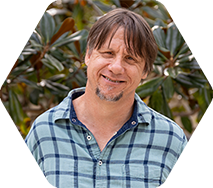Students who demonstrate motivation and talent are encouraged to gain experience in research. There are opportunities for a student to work with faculty on research projects as early as during the freshman year or as a senior for a senior thesis project. Alternatively, many of our students have successfully applied for summer research opportunities at national laboratories and other major research institutions. Below is a list of research done by Eckerd Faculty.
Under guidance of Dr. Anne J. Cox, student and faculty collaborative work in experimental physics research uses the vacuum system seen in the photo to study the properties of groups of atoms (2-100 atoms) called clusters. Undergraduate students helped build the apparatus, working on everything from electronic circuitry to plumbing for water cooling lines.
In general, cluster science research helps students to better understand the connection between individual atoms and bulk materials (e.g., how many aluminum atoms does it take for a group of them to act like a piece of aluminum that you can see without any type of microscope?).
Under guidance of Dr. Steve Weppner, students and faculty collaborate in theoretical nuclear physics. The work is done by writing computer programs to “simulate” nuclear accelerators around the world. Students help write the programs and then visualize the results using a variety of graphical packages that we have available on campus. For example, in the past they have simulated the physics of protons “smashing” into helium atoms at high speeds.
By comparing this with data collected from nuclear accelerators around the world scientists can understand better the nature of the nuclear force which powers the stars. Students have available to them to carry on this research an array of Sun Workstations (using SunOS) and personal computers (using Linux) located in the Advanced Scientific Computing Laboratory. Students recently have written an optical potential calculator which lets researchers from around the world execute the simulation
Dr. Fernandez is interested in the rich nonlinear dynamics of fusion and astrophysical plasmas, as well as plasmas in electric propulsion devices like Hall thrusters. Applications of Hall thrusters include satellite station keeping and orbit transfer. The recent SMART 1 research mission to the moon by the European Space Agency employed a Hall thruster as its main propulsion mechanism. Hall thrusters generate thrust by ejecting a plasma via an electric field (unlike chemical rockets which generate thrust as a result of the combustion of propellant). While the basic operation of these thrusters is understood, key physics issues remain open for investigation.
Dr. Fernandez, in collaboration with Mark Cappelli’s group at Stanford University, has developed a hybrid Particle in Cell (PIC) code to simulate the physics in these engines. The two dimensional simulation resolves the plasma density, electron temperature, electric current and potential, as well as ion and neutral dynamics in an non-uniform geometry covering the thruster channel and near plume. This work supports Mark Cappelli’s ongoing experimental research effort at Stanford, where a prototype Hall thruster is in operation in Professor Cappelli’s Plasma Dynamics Laboratory. Eckerd College students have been involved in this research as well, and their work has been presented at national meetings. Recent results, involving a new Hall thruster code that Dr. Fernandez is developing, have been presented at the 29th International Electric Propulsion Conference at Princeton University.
Dr. Fernandez also studies turbulence in astrophysical plasmas like the interstellar medium and solar wind, as well as turbulence in magnetically-confined fusion devices like tokamaks. Turbulence is believed to be a major obstacle in the achievement of nuclear fusion, but great progress has been made. Dr. Fernandez’s research has resulted in collaborations with the University of Wisconsin and the TFTR tokamak plasma physics group at Princeton University.






